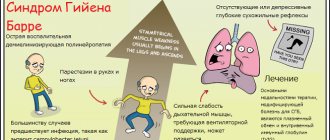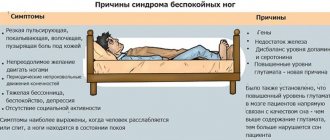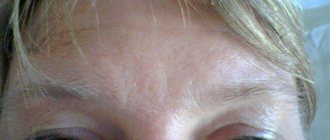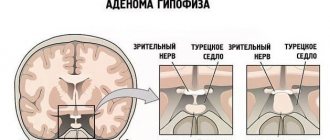Causes of the disease
Psychoorganic syndrome can be diagnosed in representatives of any population group. However, this disorder most often affects older people, who are less able to adapt. Many different factors can provoke this disorder. Among the most common reasons, doctors usually identify the following:
- Various diseases that are atrophic in nature - for example, Parkinson's disease, Alzheimer's disease.
- Pathologies that affect the circulatory system - atherosclerosis, high blood pressure.
- Infections – both brain and general. For example, neurosyphilis or encephalitis lead to irreversible changes in brain tissue.
- Brain oncology.
- Head injuries.
- Epilepsy attacks.
- Intoxication due to drugs or stimulants.
- Disturbances in the functioning of the endocrine system.
In this case, a psychoorganic syndrome can be either a residual disorder or a consequence of suffering one or another pathology of the central nervous system.
Forecast
In psychopathic-like schizophrenia, the prognosis is favorable. When the disease is detected at an early stage of its development, comprehensive treatment allows for stable remission and recovery. A similar outcome is observed in 85-90% of people with this form of pathology. If the disease progresses and the patient does not receive therapy, further progression is possible.
All patients with pseudopsychopathic schizophrenia are monitored by a psychiatrist. They are recommended to visit a specialist once every six months to monitor the effectiveness of the treatment.
The prognosis of the pathology that develops for such serious reasons differs from the degree and depth of the disorder. The prognosis is also different for acute psychoorganic and chronic forms. In acute psychoorganic disorders, the prognosis is even more favorable if you approach the relief of the disorder in a timely manner and using adequate approaches.
Loss of contact with society is usually an inevitable manifestation of a psychoorganic syndrome. During a medical examination, an individual is often diagnosed with loss of ability to work and the onset of disability.
Psychoorganic syndrome is not completely curable; it can be stopped if relief is started in time and correctly.
Psychotherapeutic support groups and medication will help maintain stability, stopping the progression of psychoorganism. The prognosis is improved by adequate family care.
The prognosis is also influenced by the degree of weather lability of the patient. The more symptoms that occur during meteorological changes, the more the individual is susceptible to negative effects and the more unfavorable the prognosis.
Preventive goals are to avoid exposing a person to various negative factors and to protect against the development of pathologies leading to psychoorganic syndrome, although this is not always possible.
The information presented in this article is intended for informational purposes only and cannot replace professional advice and qualified medical care. If you have the slightest suspicion that you have this disease, be sure to consult your doctor!
Symptoms
This syndrome is represented by three types of disorders, which are otherwise often called the Walter-Buehl triad. This:
- Impairments in memory (a person begins to suffer from amnesia or, conversely, remembers too much and cannot get rid of unnecessary information).
- Intellectual impairments (the level of generalization, the ability for concrete thinking, and comprehension are significantly reduced).
- Problems in terms of emotions (a reduced emotional background or, conversely, an attack of euphoria may be observed; the patient is emotionally labile, exhibits weakness or emotional rudeness).
At the same time, the severity of manifestations of psychoorganic syndrome may vary. The initial manifestations are pseudoneuroses in the form of asthenic symptoms, as well as personality disorders (sharpening or, on the contrary, complete leveling of personality traits). The most serious symptoms present a picture of total dementia.
Psychoorganic syndrome: symptoms
The symptoms of the syndrome are distinguished by a variety of mental manifestations.
The development of the disorder is usually accompanied by a noticeable change in the character and personality of the patient. In the absence of proper therapy, the characteristics of a formed personality can be transformed until they disappear completely. Often, psychoorganic syndrome is characterized by the development of asthenia, problems with concentration, increased distractibility, weakness and excessive irritability. At the same time, a person loses criticality and control over his own actions, judgments are formed at a primitive level, and thinking “gets stuck” in small details.
The most severe manifestations of the disorder lead to organic dementia, which is characterized by memory decay, increased emotionality, short-term or prolonged clouding of consciousness in the form of deafness.
The mechanisms of development of the disease rely on the inhibition or complete cessation of the functioning of certain neurons in the cerebral cortex. In the later stages of the development of the syndrome, changes in cell metabolism, disruption of metabolic processes in the body, insufficient absorption of glucose, deterioration in the outflow of cerebrospinal fluid and blood supply to certain areas of the brain tissue are possible.
Psychoorganic syndrome: its manifestations and diagnostic significance in practice
Depending on the stage, the syndrome may manifest itself in different ways. In the early stages, the disease may be accompanied by symptoms characteristic of other diseases, which complicates the diagnostic process. Sometimes the process of correctly formulating a conclusion is greatly complicated due to these manifestations; doctors make an incorrect diagnosis, but in reality the patient suffers from a psychoorganic syndrome. ICD-10 lists the following symptoms of the disease at the initial stage:
- constant thirst accompanied by migraine attacks;
- appetite disorders;
- sensitivity to weather changes - weather dependence;
- dizziness;
- failures in sleep mode;
- vegetative-vascular dystonia.
Along with these symptoms, the Walter-Bühel triad is also observed. If a patient has memory impairment, this will be noticeable at all stages of the disease. A person has problems with both reproducing information and remembering. It is also difficult for the patient to navigate space and time. Ultimately, difficulties are also observed in orientation in one’s own personality.
Asthenic option
With the development of asthenic psychoorganic syndrome, disturbances are noticeable in the areas of memory and intelligence. Emotional weakness and lability of nervous processes, incontinence of emotions also come first. A person feels problems with successfully performing usual work, gets lost in simple situations, feels constant unreasonable anxiety and a sense of increased responsibility. These disorders are accompanied by frequent headaches and loss of orientation in space.
Manifestations of asthenic syndrome are clearly noticeable when observing effects associated with dynamic changes in brightness. Here it is worth highlighting the flickering of multi-colored lights, ripples on the water, photo flashes, alternating light, etc. In this case, the patient feels a feeling of nausea, aching in the eyes, which gradually turns into headaches.
People susceptible to asthenic disorders react extremely negatively to stuffiness, sudden changes in climatic conditions, and lack of free space. Such individuals easily get tired of noisy crowds and tend to gradually reduce the frequency of contacts with others. A quiet, secluded vacation can help alleviate the condition of asthenic syndrome.
Options for the development of the disease
In the initial stages, there may be anxious suspiciousness and mild irritability. In the future, these symptoms gradually disappear. They seem to “dissolve” in an increasing decline in intellectual abilities, memory, and empathy. The syndrome can develop according to one of four scenarios:
- Asthenic option. At this stage, patients experience rapid physical and mental exhaustion. The person becomes very irritable, he is unstable in expressing his emotions. Even the smallest environmental irritant - sound, smell - can react painfully. This scenario assumes minor changes in intelligence; Only minor memory impairment may occur.
- Explosive psychoorganic syndrome is the next stage of the disease. It is a combination of emotional excitability (aggression, irritability), moderate memory impairment, and disturbances in adaptation to the external environment. Patients also experience a weakening of will and self-control. The patient becomes very impressionable, sometimes experiencing hysterical states. Alcohol abuse may often occur at this stage. The patients' general condition worsens. Super valuable ideas may arise.
- Euphoric and apathetic scenarios. Patients show complete failure intellectually. There are memory impairments and the ability to remember current events. Both scenarios can be considered types of dementia. As for the euphoric version, there is an increase in mood, and states of complacency and goodwill are not uncommon. However, they can sharply alternate with attacks of aggressiveness and irritation. The patient may become tearful and helpless.
Negative symptoms
Intellectual impairments in patients are manifested primarily by a decrease in criticism in self-esteem and assessment of the environment. Thus, the patient fairly correctly assesses the bad and the good, but in relation to others he commits the wrong actions, speaks tactlessly, without understanding this. The ability to acquire new knowledge deteriorates to varying degrees, the volume and quality of knowledge acquired in the past decreases, and the range of interests is limited.
Thinking becomes conservative, one-sided, which, together with an altered assessment of the environment, leads to a disruption in the patient’s ability to grasp the situation as a whole. Speech deteriorates, in particular oral speech (vocabulary decreases, the structure of phrases becomes simpler, the patient more often uses verbal templates and auxiliary words). In a conversation, he is not able to highlight the main thing, he is easily distracted by minor details and gets stuck in them.
Since the key point in dementia caused by psychoorganic syndrome is memory impairment, intellectual impairment in patients manifests itself first, the ability to acquire new knowledge deteriorates to varying degrees, the volume and quality of knowledge acquired in the past decreases, and the range of interests is limited.
Subsequently, speech deterioration occurs, in particular oral speech (vocabulary decreases, the structure of phrases becomes simpler, the patient more often uses verbal templates and auxiliary words). It is important to note that memory impairment applies to all types. Memorization of new facts deteriorates, that is, memory for current events suffers, the ability to retain what is perceived and the ability to activate memory reserves decreases.
Features of the apathetic variant
As for the apathetic scenario, here the patient behaves in a stereotyped manner and lacks spontaneity. The circle of his interests narrows sharply; he becomes indifferent to others and to himself. The patient is not able to switch from one topic of conversation to another, but it often happens the other way around - he slips from the topic under discussion to an unrelated one.
At times, the apathetic scenario can resemble the final stage of schizophrenia. Only a doctor can establish the correct diagnosis by analyzing in detail all the symptoms of the disease. In particular, you should pay attention to violent attacks of crying or laughter, which are not characteristic of schizophrenia.
Apathetic and euphoric options
These stages of psychoorganic syndrome manifest themselves in the patient’s inability to carry out unremarkable intellectual activities. Therefore, most often both variants of the syndrome are regarded by specialists as dementia.
The euphoric version is characterized by sudden mood swings towards complacency, but attacks of anger are not uncommon, alternating with increased sentimentality and flowing into complete helplessness.
A pronounced sign of the course of apathetic syndrome is the so-called aspontaneity, which is manifested by a maximum narrowing of the circle of communication, loss of interest not only in others, but also in the development of one’s own personality. Such patients are unable to quickly switch between individual topics; speech is filled with details of extraneous events and a noticeable desire to slip away from the main topic of communication.
Often, a pronounced psychoorganic syndrome, regardless of its variant, is marked by anxious suspiciousness, which subsequently dissolves in a decrease in intelligence and a lack of understanding of generally accepted principles of relationships.
Acute and chronic course
During the psychoorganic syndrome, the ICD identifies two more variants of the disease - chronic and acute. As for the latter, it is characterized by a sudden manifestation. The acute condition can last from several days to several weeks. In the future, relapses that become chronic are not excluded.
As for the chronic syndrome, the symptoms can often be subtle. The disease is characterized by a different course, and its symptoms largely depend on the characteristics of the previous disease.
- For example, with Pick's disease or Huntington's chorea, the syndrome progresses and quickly leads to dementia.
- In cases of illness resulting from traumatic brain injury, the course of the disease is as close as possible to stationary.
- When benign tumors occur, remissions are often possible.
Clinical manifestations
The symptoms are mild and may not be noticed by others for a long time. There are no positive symptoms (delusions, auditory and visual hallucinations). Main features:
- causeless attacks of aggression and rage;
- lack of pity for surrounding animals and people;
- constant anger, which periodically manifests itself in outbursts of rage;
- tendency to antisocial behavior: a person tries to harm others by uttering unpleasant words; a child can deliberately break toys, household items and devices;
- drug and alcohol use.
Patients, starting in adolescence, begin to lose social connections. They withdraw socially from friends and family members, showing a tendency to contact strangers. When communicating with a person, a large number of plans are revealed, most of which are impracticable. Against this background, the patient is not able to perform simple tasks during the day, as he is focused on “big” goals.
Manifestations of the syndrome in childhood
The disease is extremely rare in children. However, according to the ICD-10 classification, its manifestations differ significantly from those observed in adult patients. This is due to the fact that most mental functions have not yet been fully developed. Depending on age, signs of the disease in children can vary significantly.
Young children may experience delays in speech development. Children have difficulty remembering new words. Unstable mood, as well as sleep disturbances, should attract attention. Sometimes there is fussiness.
As for patients of preschool age, disturbances associated with the emotional-volitional sphere may be observed. The child's behavior is characterized by importunity and impulsiveness. Fine motor skills suffer, and the child’s inability to concentrate is visible.
School-age children may experience cognitive impairment. In addition, increased self-criticism, as well as impulsiveness, should attract attention.
Prevention
Prevention is based on eliminating trigger factors. It is impossible to eliminate a genetic predisposition, however, it is important to remember that it only manifests itself if a person has a predisposing influence. In this regard, to prevent pathology, doctors recommend:
- Create an atmosphere of trust and understanding in the family. Under no circumstances should you scold a child for no reason. It is necessary to strive for constructive criticism of children’s actions, not their personalities.
- Violence against a child is unacceptable.
- Smoking, drinking alcohol and drug addiction should be excluded. The use of psychoactive substances is one of the main reasons for the manifestation of schizophrenia in people of any age.
- Nutrition should be rational and contain the required amount of vitamins and microelements.
- Regular exercise (3 times a week or more) has a positive effect on the condition of the central nervous system.
If you notice any symptoms of schizophrenia, you should immediately seek professional help. The specialist will conduct the necessary examination and be able to select individual treatment.
https://www.youtube.com/watch?v=OzJy-SzhZkc
Pseudopsychopathic schizophrenia is a type of disease characterized by the absence of positive symptoms (delusions and hallucinations) and slow progression. The disease most often develops in childhood, and therefore parents should always monitor the mental state of their children and, if necessary, consult a psychologist or psychiatrist.
Therapy
As such, there is no specific treatment for psychoorganic syndrome. Therapy is aimed primarily at eliminating the root causes that caused the syndrome. Despite the huge selection of psychotropic drugs on the market, there is no specific treatment for this disease. A psychiatrist may prescribe only maintenance therapy depending on the severity of accompanying symptoms. Treatment can be carried out in a hospital or on an outpatient basis, depending on the severity of the disease. The use of vitamins and nootropics has a positive effect. Psychiatrists often prescribe Piracetam, Cortexin, Pantogam and other similar drugs to such patients.
It should be noted that only a qualified specialist has the right to make a diagnosis and prescribe treatment. You should contact a psychiatrist, neuropsychiatrist, or local therapist if you suspect a psychoorganic syndrome. Psychiatry is an area where it is better not to delay treatment. A timely visit to a doctor will help avoid unpleasant consequences.
Treatment of psychoorganic syndrome
When starting therapy, specialists try first to identify the objective reasons that caused the psychoorganic syndrome.
Treatment here, despite the availability of a wide arsenal of pharmacological drugs, is characterized by the absence of specific agents that can be applied to all cases of manifestation of the disease. Typically, therapy for lesions of the cerebral cortex is accompanied by the use of potent antibiotics, hormonal and antiviral medications.
If it is necessary to undergo a course of pathogenetic therapy, methods of dehydration and detoxification of the body are used, medications are prescribed to help normalize metabolism and hemodynamics of the brain.











